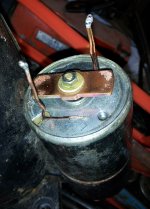Another question would be, that when it is running, what RPM does it idle at with the throttle lever pulled all the way back. It should be around 900 RPM. If it is lower, it may not be delivering enough fuel for reliable starting. That along with a slow crank might make for hard starting. I find my 284 starts a little easier, if I have the throttle bumped up a little bit, to the position that gives around 1100 RPM when the engine is running.
The glowplugs are important, and one or more not working would really effect cold startup. As mentioned, when the key is turned to the "H" position, the amp gauge needle should fully deflect to the left indicating 30amps of current draw. There are 3 plugs, each pulls about 10A, so if it only points to 20amps, one plug is probably not working. If it only pulls 10A, then 2 might be bad... As the plugs warm up, they pull less current, so initially, they should pull 30A, but as they warm, that will drop to 25A then 20A. You shouldn't run the plugs longer than about 20 seconds as you can actually damage them by running them too long.
The solenoid wire dosn't look right, but as mentioned, the solenoid is just a switch, and if it is clicking and cranking when the key is turned, it is working. The small wire probably needs to be up and soldered alongside the other wire, like the pair of wires on the opposite lead are. That side with the wire down on the case is probably on the grounded side of the solenoid coil, so that is why it is still working. If you wired it in the other way, it would probably blow a fuse as that little broken wire is against the case...
Probably of more importance is the pattern of contact on the copper conductor bar. First off they should be symetrical. The fact that they are not indicates uneven contact, and possible poor conduction. The pitting also limits contact, which creates resistance and heat, which explains why the copper is a little discolored. At the very least I would try and file those flat. If they are too pitted, you may be able to flip the bar over and use the opposite side. You must also work on the two points that the bar contacts against. These must be trued-up and equalized so the bar makes equal contact across the two points. Poor connection on that copper bar could result in poor cranking speed, just like a bad battery or ground connection would...


